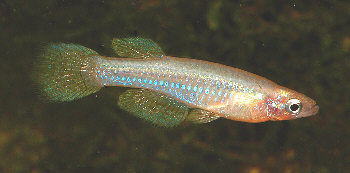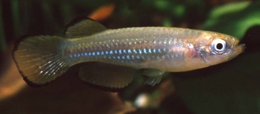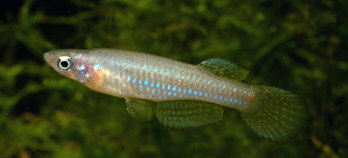| Meaning of Name |
After Sir Harry H.Johnston collector of type material. |
||
| First Description |
Haplochilus johnstonii Günther A.1893 Second report on the Reptiles, Batrachians & Fishes, transmitted by Mr. H.H.Johnston C.B from British Central Africa. Proceedings of the Zoological Society of London: p.627-628. Also described by Boulenger in 1908 in Ann. Natal Mus. i 1908, p.220. |
||
| Size |
|
||
| Meristics |
|
||
| Karyotype |
n = 24, A = 24 (Scheel 1981) |
||
| Sub-Genus |
|
||
| Group |
|
||
| Synonyms |
|
||
|
Populations
|
|
||
| Type Locality |
Mangochi (then Fort Johnston, British Central Africa). |
||
| Distribution |
Widespread in Southern Africa. |
||
| Habitat |
Small rivers & streams. Also found in the Okovango Swamp. Usually found in large numbers in vegetation around edges of biotopes. |
||
| Distinguishing Characteristics | |||
| Colour/Pattern Variability | |||
| History |
Boulenger gives the following collectors / locations in his 1915 Catalogue.
|
||
| Breeding Notes |
Bob Gunn in BKA Newsletter No. 311, August
1991 bred them in a 12 x 8 x 8" tank with water at 72 - 74°F,
pH 8. The natural method was used with eggs layed in plants &
allowed to hatch in the parents tank. |
||
| Diameter of Egg | 2 mm, 1·8 mm (Huber) | ||
| Remarks |
The female will display a horizontal grey band on the body according to mood. |


